M1: 23 Aug 2014 - Macclesfield
It was quite a daunting thought going to this Day Course – being 18 with only 3 years ringing experience I wondered whether I was capable of being able to teach someone.
The ITTS Module 1 Day Course was held at Macclesfield Parish Church with adaptions including modern stair casing, conference room with utilities next to a fairly spacious ringing room made it ideal for holding the course. The course had a lot of information to take in, especially for someone who was rather new to teaching. However, Pip Penney (who was running the course) provided a lot of energy and enthusiasm to the course which made it incredibly enjoyable. A main point that Pip made very clear was that bell handling is a key aspect to progression with ringing; without proper handling this can make good striking and method ringing harder to do.
If I had to pick a keyword it would be Cerebellum. The importance of the Cerebellum was emphasized many times throughout the day, that once movement is stored in the Cerebellum it will become very hard to change and correct. This shows why teaching good bell handling first time is essential, as it is difficult to change the movement that has been learned and stored as a template in the Cerebellum because it will continue to be used throughout a person’s ringing career.
Towards the end of the course after covering how to teach bell handling and ringing up and down, we covered looking at handling faults. This was good to do as by understanding what are the common handling faults and how they are formed, we can then understand how to correct them or even prevent them from occurring in the first place.
By the end of the course I felt more empowered to be able to teach someone else how to handle a bell, as well as feeling confident at being able to do this. Personally I found this course incredibly useful.
Nathan Cox

Course Tutor
Pip Penney
Teaching Bell Handling
Practical advice for teachers, right from the first lesson.